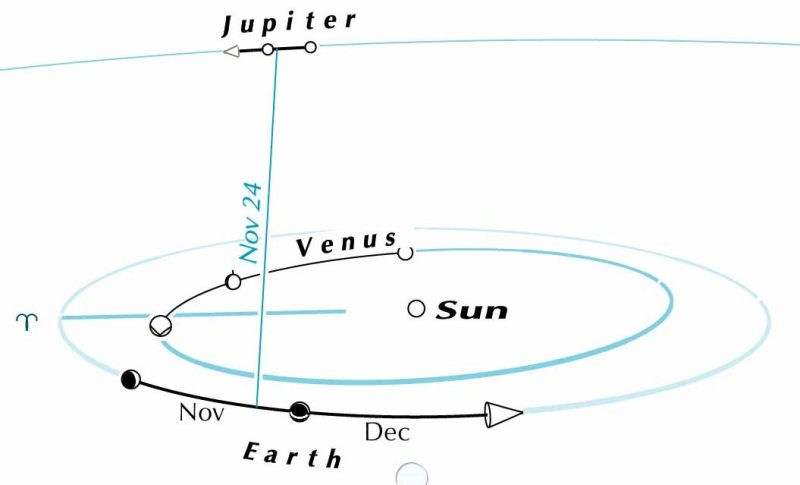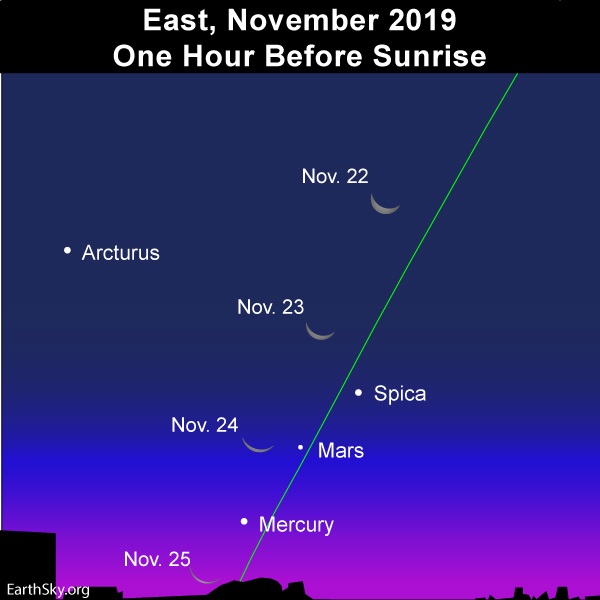Wow! The sky’s two brightest planets – Venus and Jupiter – have been close together in the west after sunset for some days. Their conjunction was yesterday, November 24, 2019. Venus, the brighter planet as seen in Earth’s sky, passed a scant 1.4 degrees south of Jupiter. For reference, that’s about three moon-diameters, or about the width of your index finger held at arm’s length.
It’s not too late to see the planets. Jupiter will be falling into the sun’s glare, while Venus is climbing out of it, in the coming weeks. The best time to look will be soon … as close to the conjunction date as possible. The closer Jupiter gets to the sunset, the harder it will be to see.
To maximize your enjoyment of these dazzling worlds – and especially if you’re in the Northern Hemisphere, where the two now appear low in the western twilight sky – be sure find an unobstructed horizon in the direction of sunset.
No matter where you are on Earth, Venus and Jupiter will be the first objects in the sky to pop out at dusk. They’ll follow the sun below your horizon as twilight gives way to dark.
See more photos of Venus and Jupiter at EarthSky Community Photos.
EarthSky 2020 lunar calendars are available! They make great gifts. Order now. Going fast!


The last Venus-Jupiter conjunction happened 10 months ago, on January 22, 2019, and the next one will occur on February 11, 2021. There will be no Venus-Jupiter conjunction in 2020.
So it’s relatively rare to see Jupiter and Venus – the sky’s two brightest planets – in the same part of the sky. Don’t miss them.
Read more about Venus and Jupiter from astronomer Guy Ottewell.

Here are the approximate setting times for Venus and Jupiter at various latitudes across the globe:
35 degrees north latitude
Venus and Jupiter set about 1 hour and 40 minutes after sunsetEquator (0 degrees latitude)
Venus and Jupiter set about 1 hour and 50 minutes after sunset35 degrees south latitude
Venus and Jupiter set about 2 hours after sunset
Want more specific information? Click here for a recommended sky almanac.

You might catch Venus popping out into the evening twilight some 30 minutes (or less) after sunset, and then see Jupiter coming out 15 or so minutes after Venus first appears. The twosome should be pretty easy to see with the eye alone about one hour after sunset.
But bring along your binoculars, anyway. It’s a lot of fun to use binoculars to spot these embracing worlds before they pop into view with the eye. Plus, binoculars will enhance your view.
By the way, the interval between successive Venus-Jupiter conjunctions can be as little as 10 months or as long as 15 months. The mean interval is 13 months. Most of the time, there is one and only one Venus-Jupiter conjunction in one calendar year (though it is possible to have none).
The year 2019 stands as an exception because two Venus-Jupiter conjunctions are happening this year. They occur 10 months apart, with this year’s first Venus-Jupiter conjunction on January 22, and the second on November 24.

It appears that similar Venus-Jupiter conjunctions recur in periods of about 24 years plus one week, whereby Venus and Jupiter return to nearly the same place relative to the sun, the stars of the zodiac, and the horizon. Hence, similar Venus-Jupiter conjunctions occurred 24 years ago (January 14 and November 19, 1995) and will again take place 24 years from now (January 29 and November 29, 2043):
1995 January 14 (morning sky)
1995 November 19 (evening sky)2019 January 22 (morning sky)
2019 November 24 (evening sky)2043 January 29 (morning sky)
2043 November 29 (evening sky)
Roughly midway between these twofold Venus-Jupiter conjunction years (1995, 2019 and 2043), we find two Venus-Jupiter conjunctions in 2008 – and then 24 years later, two Venus-Jupiter conjunctions in 2032.
2008 February 1 (morning sky)
2008 December 1 (evening sky)2032 February 7 (morning sky)
2032 December 8 (evening sky)

The elongation (angular separation of the Venus-Jupiter conjunction from the sun) was 46 degrees west of the sun on January 22, 2019, and 26 degrees east of the sun on November 24, 2019. The elongations are more or less similar (within a few degrees) throughout the series: 1995, 2019 and 2043.
Interestingly, the elongations are similar – yet reversed – in these in-between years of 2008 and 2032. In 1995, 2019 and 2043, the year’s first conjunction in the morning sky showcases the conjunction near its maximum possible elongation from the sun (46 degrees west); yet, in the years 2008 and 2032, it’s the year’s second conjunction in the evening sky that presents the conjunction near maximum elongation (46 degrees east).
Want more details? Visit the Heavens-Above planet summary or enter your location and select Planets on the Heavens-Above home page. For an interactive online chart of the night sky for any location and time, visit Stellarium.
Note: When Venus is near inferior conjunction, Venus can actually conjunct Jupiter three times in four months. Venus first meets up with Jupiter going prograde (eastward in front of the stars), a second time when going retrograde (westward in front of the stars), and finally a third time when going prograde (eastward) again. For our purposes, we’re calling this three-peat performance a “single” event. This special type of triple conjunction last happened in 2015 and will next take place in 2036.
Because Venus and Jupiter beam as the third-brightest and fourth-brightest celestial bodies, respectively (after the sun and moon), Venus-Jupiter conjunctions are particularly spectacular and photogenic.
By the way, if you’re an early morning person, use the waning crescent moon to find the planets Mars and Mercury in the predawn/dawn sky right now, as shown on the sky chart below.

Bottom line: The November 24, 2019, conjunction of Venus and Jupiter is over, but you’ll be able to see these bright planets near each other in the west after sunset until about mid-December.











